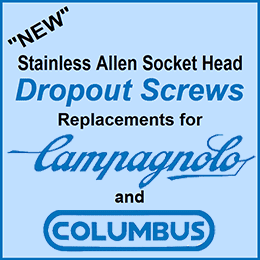Aero Bikes: History
 Sun, January 7, 2007
Sun, January 7, 2007 
Here’s a little more on the history behind aerodynamic bicycle frames; a subject that I touched on in my previous blog about the US team bikes.
In the mid 1970s there was a craze for drilling holes in components to save weight. Soon no component part of the bicycle was left untouched, with the possible exception of handlebars and stems for obvious reasons; although a few riders with death wish tendencies even tried that.
Steel frames were not immune, with cutouts in the bottom bracket shell and lugs. Towards the end of the 1970s I saw a few British Time Trial Frames with slots cut in the head tube, and matching slots in the steering column inside.
Soon bikes had so many holes in them, they didn’t have a shadow.
Aside from reducing the reliability of the frame or component, people began to point out that any gain in weight saving was offset by the increased air turbulence and the resulting drag of air passing through slots and holes.
People began to think seriously about aerodynamics. At the same time the East Germans were experimenting with aero bikes and helmets; I was one of the first in England to work with the idea in the late 1970s. I made a press tool to form round tubes into an oval shape. I also added an aerofoil behind the head tube and bottom bracket shell.
After the US team bike fiasco I lost interest but I do remember building one at the end of 1980. I had just started work for Masi in Southern California, and they had a sample set of aero tubes. (Japanese I believe.)
I built one Aero Masi frame for the New York Show in February 1981. It was built into a complete bike, light blue in color, and with all the Masi decals it was a very unique and classy looking machine. I wonder where that one is now; definitely one of a kind. 
The aero steel frame never really caught on and was only around for about two or three years. The tubes were difficult and therefore expensive to produce. The frame had to be of a lug-less construction, not conducive to mass production. The biggest drawback was the extra weight because the tubes had to be straight gauge. They couldn’t be double butted like round tubes.
Footnote: The pictures are of an English built track pursuit frame built around 1978. Note the extended seat tube, round at the top to accept the seat post. The fork crown was a modified Ron Kitching crown that took the old style narrow Reynolds fork blades, and was hand filed into the aero shape. Also, see details of the aerofoil behind the BB and head tube.
 Dave Moulton | Comments Off |
Dave Moulton | Comments Off | 
















Reader Comments (8)
You know, I think Kirkbride might have that aero frame you built for Masi. I'll have to ask him.
Thanks for the history lesson, Dave!
I believe the best looking bicycles are ones that allow form to follow function. This is a perfect example of this.
I do know that those tube sets rode well. The first race I did for Gitane was the National Capitol Open in 1981 on Hinaults personal bike. It rode great. A crash late in the race had me just saying over and over "keep it upright, keep it upright". Thankfully I did. It had aero hand filed Campy Record levers,brakes and cranks. <BR/>Off topic, I designed what I believe was one of the first 24/700 aero bikes in 1980. Had John Stinsman in T-town do the build. This bike was the impetus for the USCF to do the Funny bikes. Do you know of earlier bikes of this style? Brent Emery
John Stinsman was (is?) a frame builder from the Allentown PA area (near Trexlertown). He build a line of very nice Cro Mo frames back in the 70s. He built tandems, road bikes and track bikes. I beleive Jerry Ash rode one of his frames to a national title.